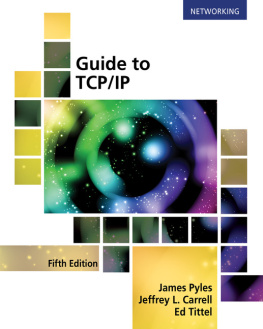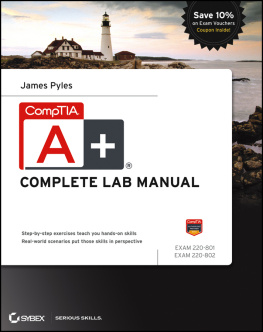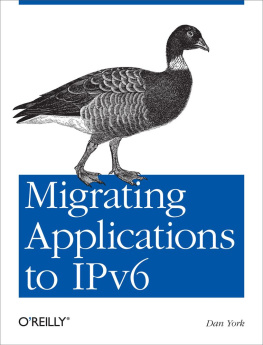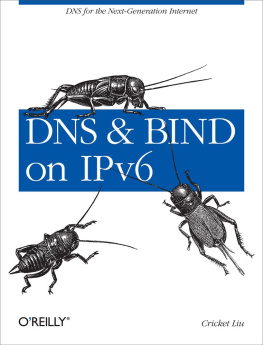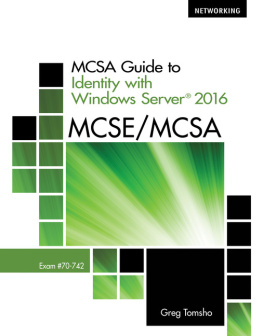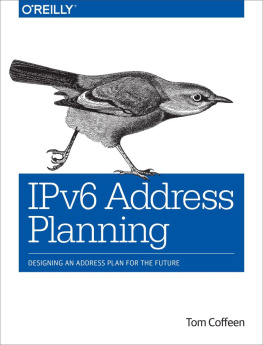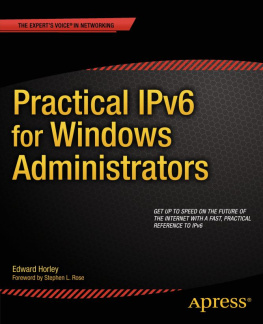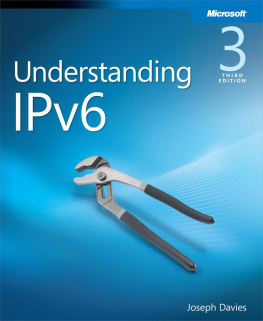Guide to TCP/IP: IPv6 and IPv4
Table of Contents
Guide
List of Illustrations
List of Tables
Copyright Statement
Guide to TCP/IP: IPv6 and IPv4
COPYRIGHT 2017, 2013 Cengage Learning
ALL RIGHTS RESERVED. No part of this work covered by the copyright herein may be reproduced or distributed in any form or by any means, except as permitted by U.S. copyright law, without the prior written permission of the copyright owner.
SOURCE FOR ILLUSTRATIONS: Copyright Cengage Learning.
All screenshots, unless otherwise noted, are used with permission from Wireshark.
For product information and technology assistance, contact us at Cengage Learning Customer & Sales Support, 1-800-354-9706
For permission to use material from this text or product, submit all requests online at www.cengage.com/permissions
Further permissions questions can be e-mailed to
Library of Congress Control Number: 2016931362
ISBN 13: 978-1-305-94695-8
Cengage Learning
20 Channel Center Street
Boston MA 02210
USA
Cengage Learning products are represented in Canada by Nelson Education, Ltd.
Cengage Learning is a leading provider of customized learning solutions with employees residing in nearly 40 different countries and sales in more than 125 countries around the world. Find your local representative at www.cengage.com
To learn more about Cengage Learning, visit www.cengage.com.
Purchase any of our products at your local college store or at our preferred online store www.cengagebrain.com.
Notice to the Reader
Publisher does not warrant or guarantee any of the products described herein or perform any independent analysis in connection with any of the product information contained herein. Publisher does not assume, and expressly disclaims, any obligation to obtain and include information other than that provided to it by the manufacturer. The reader is expressly warned to consider and adopt all safety precautions that might be indicated by the activities described herein and to avoid all potential hazards. By following the instructions contained herein, the reader willingly assumes all risks in connection with such instructions. The publisher makes no representations or warranties of any kind, including but not limited to, the warranties of fitness for particular purpose or merchantability, nor are any such representations implied with respect to the material set forth herein, and the publisher takes no responsibility with respect to such material. The publisher shall not be liable for any special, consequential, or exemplary damages resulting, in whole or part, from the readers use of, or reliance upon, this material.
Preface
Welcome to Guide to TCP/IP: IPv6 and IPv4, Fifth Edition! TCP/IP stands for Transmission Control Protocol/Internet Protocol and defines the broad family of protocols and services that make the Internet able to function as we know it today. In covering TCP/IP, this book offers you real-world examples, interactive examples, and many Hands-On Projects that reinforce key concepts and teach the use of important monitoring and management tools. This book also includes voluminous protocol traces, or decodes, that will help you understand what TCP/IP looks like, and how it behaves, on your networks.
This book offers in-depth coverage of all the salient models, protocols, services, and standards that govern TCP/IP and that guide its behavior on modern networks. Throughout the book, we provide pointed questions to reinforce the concepts introduced in each chapter and to help prepare you to interact with TCP/IP in its native habitatthat is, on the vast majority of networks in use in the world today. In addition to the review questions, we provide detailed Hands-On Projects that provide you with firsthand experience in installing, configuring, using, and managing TCP/IP on a working network. Finally, to put a real-world slant on the concepts introduced in each chapter, we also include Case Projects that pose problems and require creative solutions that should prepare you for the kinds of situations and needs youll face on a real, live network.
Intended Audience
This book is intended to serve the needs of individuals and information systems professionals who are interested in learning more about working with and on TCP/IP-based networks. These materials have been specifically designed to prepare individuals to take an active role in administering a network infrastructure that uses TCP/IP, either as its only protocol suite or in concert with other protocol suites. Those students who work their way through this entire book should be well equipped to recognize, analyze, and troubleshoot a broad range of TCP/IP-related networking problems or phenomena.
Chapter Summaries
Chapter 1 , Introducing TCP/IP, begins with a brief look at TCP/IP and then covers the structure and origins of the standards documents known as Requests for Comments (RFCs), which describe and govern TCP/IP protocols, services, and practices. From there, it explores the Open Systems Interconnection (OSI) reference model for networking, as standardized by the International Organization for Standardization (ISO), and compares and contrasts this standard model to the TCP/IP networking model, around which TCP/IP is built. The chapter then provides an overview of TCP/IP protocols, services, sockets, and ports, and it concludes with an overview of protocol analysis. Wireshark is a type of protocol analyzer that captures, unpacks, and displays the contents of traffic on a network, including TCP/IP; it plays a significant role throughout the remainder of this book.
Chapter 2 , IP Addressing and Related Topics, covers the intricacies involved in managing unique IP addresses for both 32-bit IPv4 addresses and 128-bit IPv6 addresses. Beginning with the anatomy of a numeric IPv4 address, the chapter explores IPv4 address classes, special cases such as broadcast and multicast addresses, and subnets and supernets, and reviews the reasons for classless IPv4 addressing, public versus private IPv4 addresses, and IPv4 addressing schemes. The rest of the chapter repeats this coverage for IPv6, including a review of address formats and notation, address layouts and types, and address allocations. Youll also find addressing schemes and subnetting considerations covered, along with some discussion about how to manage the transition from IPv4 to IPv6 addresses.
Chapter 3 , Basic IP Packet Structures: Headers and Payloads, covers the key components of any IP packet (both for IPv4 and IPv6): the header that describes the packet for routing, forwarding, and filtering, and the payload that contains the data that the packet is meant to convey. IPv4 and IPv6 headers are laid out and dissected in detail, including IPv6 extension headers, and the use of transport and packet handling controls are described and explored. The chapter concludes with a comparison of header structures in IPv4 versus IPv6, with a rationale to explain redesign and changes involved.
Chapter 4 , Data Link and Network Layer Protocols in TCP/IP, explores and explains the TCP/IP protocols that operate at the Data Link and Network layers in the OSI reference model. In that context, it discusses data link protocols in general, examines IP frame types, and talks about hardware addresses in the IP environment and the various protocolsparticularly ARP and RARP, for IPv4, and the Neighbor Discovery Protocol, or NDP, for IPv6that support their use. The chapter also covers TCP/IPs most important protocol at the Network layer, the Internet Protocol (IP), along with routing protocols, mechanisms, and characteristics for IPv4 and IPv6, including RIPv1 and v2, OSPF, EIGRP, and BGP, with considerations for both IPv4 and IPv6 protocols and behaviors.

